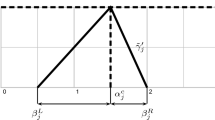Abstract
There are uncertainties in factors such as inflation. Historical data and variable values are ambiguous. They lead to ambiguity in the assessment of outstanding claims reserves. The payments per claim model can only perform point estimation. But the fuzzy linear regression is based on fuzzy theory and can directly deal with uncertainty in data. Therefore, this paper proposes a payments per claim model based on fuzzy linear regression. The linear regression method and fuzzy least square method are used to estimate the parameters of the fuzzy regression equation. And the estimated results are introduced into the payments per claim model. Then, the predicted value of each accident reserve is obtained. This result is compared with that of the traditional payments per claim model. And we find that the payments per claim model of estimating the fuzzy linear regression parameters based on the linear programming method is more effective. The model gives the width of the compensation amount for each accident year. In addition, this model solves the problem that the traditional payments per claim model cannot measure the dynamic changes in reserves.
Similar content being viewed by others
References
Yan, C., Wang, L., Liu, W., Qi, M.: Financial early warning of non-life insurance company based on RBF neural network optimized by genetic algorithm. Concurr. Comput. Pract. Exp. 30(23), 1–11 (2017)
Yan, C., Sun, H.T., Liu, W., Chen, J.: An integrated method based on hesitant fuzzy theory and RFM model to insurance customers segmentation and lifetime value determination. J. Intell. Fuzzy Syst. 35(1), 159–169 (2018)
Liu, H.T., Wang, J., He, Y.L., et al.: Extreme learning machine with fuzzy input and fuzzy output for fuzzy regression. Neural Comput. Appl. 28(11), 3465–3476 (2017)
Zuo, H., Zhang, G., Pedrycz, W., et al.: Fuzzy regression transfer learning in Takagi–Sugeno fuzzy models. IEEE Trans. Fuzzy Syst. 25(6), 1795–1807 (2017)
Baser, F., Demirhan, H.: A fuzzy regression with support vector machine approach to the estimation of horizontal global solar radiation. Energy 123, 229–240 (2017)
Ren, Y., Guo, S.Z.: Fuzzy linear regression based on structural element least squares order. Fuzzy Syst. Math. 29(01), 126–133 (2015)
Guo, Z.X., Han, R., Qi, M.R.: Emergency material demand forecasting model based on multiple fuzzy regression. J. Hebei Univ. (Nat. Sci. Edit.) 37(04), 337–342 (2017)
Gong, Y.B., Xiang, L., Liu, G.F.: Research on flood disaster classification evaluation method based on fuzzy regression model. Stat. Inf. Forum 2018(5), 65–74 (2018)
Gong, Y.B., Dai, L.L., Hu, N.: Parameter estimation of fuzzy linear regression model based on COWA operator expectation. Stat. Decis. 2018(2), 15–18 (2018)
Xiao, G.Q., Li, K.L., Li, K.Q.: Reporting l most influential objects in uncertain databases based on probabilistic reverse top-k queries. Inf. Sci. 405, 207–226 (2017)
Xiao, G.Q., Li, K.L., Li, K.Q., Zhou, X.: Efficient top-(k, l) Range query processing for uncertain data based on multicore architectures. Distrib. Parallel Databases 33(3), 381–483 (2015)
Yan, C., Li, Y.X., Sun, X.H., Liu, Z.B.: Non-life insurance reserve case for indemnity. Insur. Stud. 2015(11), 15–24 (2015)
Li, Z.X., Meng, S.W.: Automobile insurance pricing model under dependent risk conditions. Insur. Stud. 2016(7), 68–77 (2016)
Yan, C., Zhang, J., Su, R.: Case-based compensation method based on mathematical programming method considering outliers. Theory Pract. Finance Econ. 38(3), 46–51 (2017)
Yan, C., Sun, H.T., Liu, W.: Study of fuzzy association rules and cross-selling toward property insurance customers based on FARMA. J. Intell. Fuzzy Syst. 31(06), 2789–2794 (2016)
Xiao, G.Q., Li, K.L., Zhou, X., Li, K.Q.: Efficient monochromatic and bichromatic probabilistic reverse top-k query processing for uncertain big data. J. Comput. Syst. Sci. 89, 92–113 (2017)
Xiao, G.Q., Wu, F., Zhou, X., Li, K.Q.: Probabilistic top-k range query processing for uncertain databases. J. Intell. Fuzzy Syst. 31(2), 1109–1120 (2016)
Li, Y.Q., Yan, C., Liu, W., Li, M.Z.: A principle component analysis-based random forest with the potential nearest neighbor method for automobile insurance fraud identification. Appl. Soft Comput. 70, 1000–1009 (2018)
Tanaka, H., Uejima, S., Asai, K.: A liner regression analysis with fuzzy functions. IEEE Trans. Syst. Man Cybern. 25(2), 162–174 (1982)
Zadeh, L.A.: Fuzzy sets. Inf. Control 8(3), 338–353 (1965)
Chen, J.G., Li, K.L., Tang, Z., Yu, S., Li, K.Q.: A parallel random forest algorithm for big data in Spark cloud computing environment. IEEE Trans. Parallel Distrib. Syst. 28(4), 919–933 (2017)
Zhou X., Li K.L., Yang Z.B., Xiao G.Q., Li K.Q.: Progressive approaches for Pareto optimal groups computation. IEEE Trans. Knowl. Data Eng. (in press) https://doi.org/10.1109/TKDE.2018.2837117 (2018)
Zhang, A.W.: Comparison of fuzzy linear least squares regression based on different distances. J. Jiangsu Univ. Sci. Technol. (Nat. Sci. Edit.) 26(5), 509–513 (2012)
Li, K.L., Yang, W.D., Li, K.Q.: Performance analysis and optimization for SpMV on GPU using probabilistic modeling. IEEE Trans. Parallel Distrib. Syst. 26(1), 196–205 (2015)
Chen, Y.D., Li, K.L., Yang, W.D., Xiao, G.Q., Xie, X.H., Li, T.: Performance-aware model for sparse matrix–matrix multiplication on the sunway TaihuLight supercomputer. IEEE Trans. Parallel Distrib. Syst. (in press) https://doi.org/10.1109/TPDS.2018.2871189 (2018)
Han, T.X.: Non-life Insurance Actuarial, pp. 154–200. Chinese financial & Economic Publishing House, Beijing (2010)
Acknowledgements
This work was financially supported by the Project of National Natural Science Foundation of China(61502280,61472228).
Author information
Authors and Affiliations
Corresponding author
Ethics declarations
Conflict of interest
The authors declare that they have no conflict of interest.
Ethical approval
This article does not contain any studies with human participants or animals performed by any of the authors.
Rights and permissions
About this article
Cite this article
Yan, C., Liu, Q., Liu, J. et al. Payments Per Claim Model of Outstanding Claims Reserve Based on Fuzzy Linear Regression. Int. J. Fuzzy Syst. 21, 1950–1960 (2019). https://doi.org/10.1007/s40815-019-00617-x
Received:
Revised:
Accepted:
Published:
Issue Date:
DOI: https://doi.org/10.1007/s40815-019-00617-x




